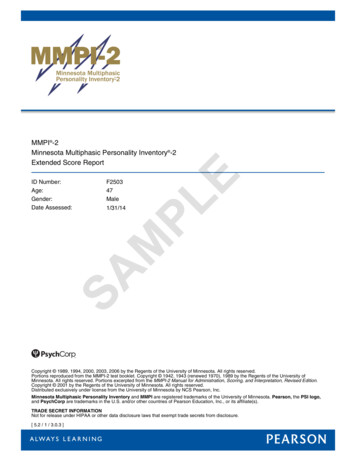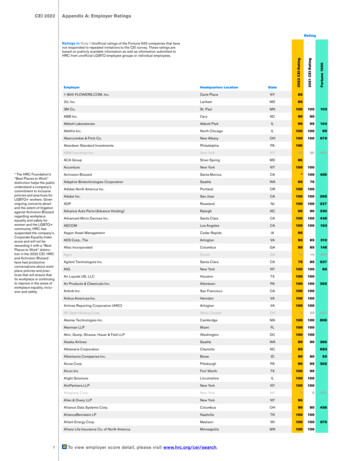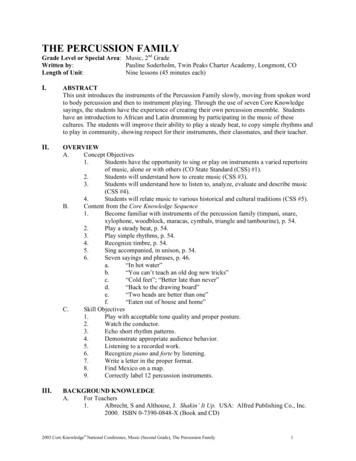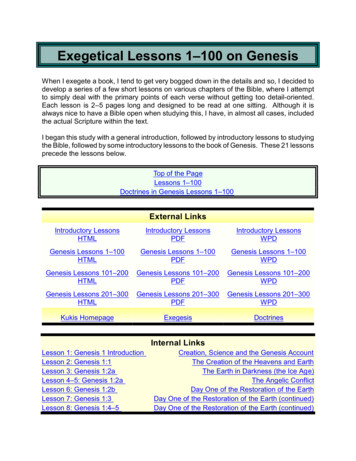
Transcription
SnijdersLessons from 100 ATES projectsThe developments of aquifer storage in the Netherlandsby Aart L.SnijdersIF Technology, P.O. Box 605, NL 6800 AP Arnhem, The Netherlands, fax. ( )3 1-26-446 0 1 53, office@if-tech.nlKEY-WORDSaquifer, energy, storage, projects, experienceAbstractAt the beginning of 2000, over 100 projects applying cold storage or a combination of cold storage and lowtemperature heat storage were operational in the Netherlands. The cooling capacity supplied through cold storage isbetween 500 and 1000 kWt for most projects. Over 40% of the projects concern large office buildings while theremainder are on the whole evenly distributed over public buildings, hospitals, industry and agriculture.It has taken over 15 years for Aquifer Thermal Energy Storage (ATES) to become considered a standard technology.This publication discusses the lessons that can be learned from the technological development as well as the role theclient, the consultant and the government play therein.IntroductionIn 1982 the SPEOS Aquifer Thermal Energy Storage (ATES) project was realised in Dorigny, Switzerland. Thisproject was a high temperature pilot project in the framework of the lEA Storage Programme. Similar pilot projectswere realised in Denmark (H0rsholm) and the USA (St. Paul - Minnesota) during the same period.Although it was intended to fit the pilot projects into an energy supply system after the experimental phase, this didnot occur in any of the projects due to serious operational problems. However, these also were the value of thosepilot projects for the development of ATES: they made clear what the technical problems were that had to be solvedbefore ATES could be applied on a commercial basis. For high temperature heat storage it particularly concerned:(lEA, 1995)clogging of wells and heat exchangers due to fines* and precipitation of mineralswater treatment to avoid operational problems resulting from the precipitation of mineralscorrosion of components in the groundwater systemautomatic control of the groundwater system.In the period 1985- 1995 much research was done to solve the technical problems. This research was partiallyundertaken within national research programmes and partly within the framework of the lEA Storage Programme.The research has demonstrated that the technical problems encountered can be solved. Furthermore, it has madeclear that the technical problems faced in cold storage and low temperature heat storage are much smaller than thosemet in high temperature heat storage, see table 1 (lEA 1995).147
Lessons from100 ATES projects - The developments of aquifer storage in the NetherlandsTERRASTOCK 2000, Stuttgart, Germany, August 28 until September 1, 2000Table 1: Water treatment methods applicable to ATESProblemAvoid problemControl problemPreciptation of carbonatesIon exchangeFluidized bed reactor/heat exchangerCO2 treatmentPrecipitation of iron/manganesePressurized, air tight systemIn-situ oxidationBioreactorGas cloggingPressurized, air tight systemPartial degassingPresent status in the NetherlandsIn the Netherlands, Aquifer Thermal Energy Storage started to be implemented in the early eighties. In first instancethe objective was to store solar energy for space heating in winter. R&D activities and the first demonstrationprojects were financed within the framework of the National Research Programme on Solar Energy (NationaalOnderzoek Programma Zonne-energie). The first demonstration projects concerned:the storage of solar heat for space heating in an office building (storage temperature 30 C) (VAN DERBRUGGEN et al. 1985);the storage of winter cold to cool a printing office (storage temperature 6 C) (VAN HOVE et al. 1988);the storage of residual heat from a combined heat and power plant for space heating of a university building(storage temperature 90 C) (VAN LOON et al. 199 1);the storage of solar heat for space heating some 100 residences (storage temperature 60 C) (WIJSMAN 1983).An aquifer was not used for heat storage in the latter project; instead vertical soil heat exchangers were used. Giventhe good experience with the first aquifer storage projects and the fact that in the Netherlands aquifers can be foundalmost everywhere, the application of thermal energy storage in aquifers in particular has been further developed inthe Netherlands.At the beginning of 2000, over 100 projects in which ATES is applied have been realised in the Netherlands; almostevery major city has a number of projects in operation. The aim of most ATES projects is to store cold in winter forcooling in summer, see table 1. In general, cooling is direct, that is to say without using a chiller. In most projectsthe cooling capacity supplied from storage lies between circa 500 kWt and 1000 kWt. This means that by applyingcold storage these projects economise on a large chiller.The heat released during cooling is stored in the aquifer. If possible the heat is used for heating during the winterseason. This combination is called "Cold Storage and Low Temperature Heat Storage", see table 2. The temperaturelevels of the heat stored in summer are fairly low so that it is not always possible to utilise the heat in winter.If therealised projects are distinguished per application area, the situation as shown in table 3* occurs. Over 40% ofthe realised projects involve a combination of cooling and heating of office buildings. This generally concerns largeoffice buildings that have air conditioning (floor area between 10,000 and 100,000 m2). The remaining projects areabout equally distributed over the other application areas. The category "public buildings" concerns buildings withlarge numbers of visitors such as shopping malls, congress centres, exhibition halls, airport terminals andamusement parks. The common characteristic of these buildings is thus that cooling, heating and ventilation are fora significant part determined by the fact that there are many people present at the same time.148
SnijdersTable 2: Realised ATES projects - storage temperatureAimType of StorageCoolingCold storageCooling and heating Cold storageTemperature levelPercentage of projects 12 DC27 12 DC58and low temperature heat storage12-20 DCHeatingLow temperature heat storage20-50 DCHeatingHigh temperature heat storage23Table 3: Realised ATES projects-applicationsApplicationPercentage of projectsOffice buildings43Hospitals12Public buildings (malls, congress centres, etc.)18Industry12Agricultural applications15Lessons from 100 projectsThe fact that at the beginning of 2000 there were over 100 ATES projects in operation, and that some tens ofprojects were under preparation or construction, demonstrates that Aquifer Seasonal Cold Storage and LowTemperature Heat Storage is currently an accepted technology with a commercial basis in the Netherlands. Thissituation has not arisen without a struggle, however. What are the main lessons that can be learned from thedevelopments between the first pilot projects of the early eighties and the present application of ATES?The first projectsThe first projects had to be technically successful.For further introduction, it was essential that the first projects functioned properly because new clients almostwithout exception wanted information or even gathered information themselves on the progress of those projects.This conflicts with the inclination of technicians to highly optimise a new technology on paper. In the case ofAquifer Thermal Energy Storage this led to systems that were too complex, had too many different modes ofoperation and a too complicated control. The previously mentioned office project in which low temperature solarheat was stored is a particular example of this. Besides storing low temperature heat in an aquifer, that projectapplied a gas motor heat pump and newly developed solar collectors. The aquifer storage has always functionedwithout problems. The energy supply system was simplified a few years after operation started.It is important that all parties realise that the first projects have to be successful. It means that clients will have toaccept some problems in the start-up phase and that the research institutes, consultants and contractors involved inthe construction will in retrospect note that they have put money into the project in order to solve the problems inthe start-up phase. This is however inevitable to gain experience with a new technology: "experience is what youget, when you don't get what you want".149
Lessons from100 ATES projects· The developments of aquifer storage in the NetherlandsTERRASTOCK 2000, Stuttgart, Germany, August 28 until September 1, 2000Technological developmentsThe technical possibilities are greater than first appear.In the first projects thermal energy storage was added to an energy supply system as an additional component. Theprest of the system determined the boundary conditions for the storage system: cold storage had to supply 6 C to be:r-able to utilise the cold in the conventional building cooling systems. No account was taken of the specific properties1of aquifer cold storage whereby a higher temperature (8-10 QC) is better because then fewer problems occur whenaloading the store during winter. In later projects building heating and cooling systems were adapted so that a betterutilisation of the stored cold and low temperature heat became possible. In this development RVAC engineersespecially play a major part.In Figure 1 an example is given of a system concept for a building in which the storage system is integrated into theair conditioning system. This concept is especially applicable for buildings in which cooling is entirely or almostentirely via ventilation air. The water/air heat exchangers in the air handling units are over-dimensioned so that therequired cold (air temperature and relative humidity) can be achieved with a relatively high supply watertemperature. During the winter season the same water/air are used to heat the ventilation air, using the lowtemperature heat stored. The heat released in summer when cooling the ventilation air is stored and utilised inwinter, while the cold groundwater created then is stored and used for cooling in summer.WinterTemp 7 CSummerTemp 15 CPreheatlngOutside airOfficebuilding7 C ---.,1-""----. 15 CColdOutside airre. """.,1 .,ColdFigure 1. A TES system integrated with building airconditioning system.150. -IIIIII. Officebuilding150C
SnijdersIn the system concept shown in Figure 1 there is a risk of heat exchanger freezing and thus being damaged in winter,which has occurred in a few projects. A solution for this problem is the application of water/air heat exchangersprovided with Thermo Guard equipment developed in Sweden (BRANNSTROM 1991) now on the market in theNetherlands. The batteries may still freeze but no damage will be incurred.This example illustrates that technological development is not finished as soon as the new component, in this caseaquifer storage, functions well. Other examples of further developments include:*the application of what is called a mono-well in which two filters are placed in one borehole, for small-scaleprojects;*the integration of wells for thermal energy storage with the fire extinguishing system in industrial projects.Role HVAC engineerMost HVAC engineers avoid risks.At present aquifer cold storage is considered one of the options to save energy when cooling and heating large officebuildings. All renowned installation consultancy companies have by now designed some projects applying ATES. Inthe early stages of ATES application however, the large installation consultancy companies were reserved aboutrecommending this technology to their clients. It were the small companies, who saw the possibility ofdistinguishing themselves by applying new technologies, who contributed to the success of the first ATES projects.Role clientThe motives of clients to apply ATES have changed in the course of time.The first clients (early adapters) recognised the environmental advantages of the new technology and offered anopportunity to apply it for a first time rather than that they applied the technology on the basis of economicalmotives. At the same time they capitalised on the publicity opportunities offered by the attention the media gave tothe first subsoil cold and heat storage projects. To minimise their technical and financial risks, the first clients alsomade sure that their technions had sufficient time to follow the implementation day by day.As faith in ATES technology increased, deciding whether or not to apply ATES became based on more conventionaleconomic, social and location-specific factors.For projects with relatively large cooling and heating capacities the economical boundary conditions are favourable:because chillers are avoided the additional investments for aquifer storage are small while there is a considerablesaving on energy consumption. This results in a payback period of about 5 years. Furthermore, it has becomegenerally accepted that investment decisions include environmental aspects. In many cases this has resulted inATES being chosen instead of a conventional system with chillers and gasfired boilers despite the fact that applyingATES involves extra complications for the client such as additional licenses and more parties on the building site(geohydrological consultant and drilling company).Role governmentSubsidy arrangements do not warrant the implementation of a new technology.Besides financing R&D activities, financial support from the government has proven necessary for the first(demonstration) projects in order to lay a foundation for the implementation of the technology. In the follow-upphase subsidising feasibility studies has contributed to lowering the threshold to at least compare the application ofATES with a conventional installation before starting a project.At present aquifer cold storage is ranked among the renewable energy resources because ambient cold is used forcooling (and possibly ambient heat for heating). For businesses, project developers and institutions that applyrenewable energy resources, there are fiscal facilities or subsidies. The impact of such arrangements on the15 1
Lessons from100 ATES projects - The developments of aquifer storage in the NetherlandsTERRASTOCK 2000, Stuttgart, Germany, August 28 until September 1, 2000application of cold storage particularly lies in that the government recognises that ATES application contributes to asocially desirable development.On the other hand, the client encounters the government as licensor for the use of groundwater. To this end,questions about the environmental impacts of ATES must be answered by or on behalf of the client, while duringoperation the project must be monitored and reported on. In this way the government has two faces towards theclient: that of the stimulating party for the application of ATES and that of the party that raises barriers against itsapplication. Tuning the policy between the various ministries and the national and provincial authorities hastherefore certainly been as important for the implementation of ATES as the subsidy arrangements.Present projectsAs soon as a technology has passed the stage of childhood, numerous parties appear on the market to take thepickings.The fact that ATES has become a standard technology does not only appear from the fact that tens of projects areimplemented each year. This situation is further illustrated by the developments on the market:various parties on the market, such as drilling companies and installation companies, are starting to offer turn key cold storage systems:standardised cold storage systems are entering the market, in particular for small-scale projects;some utilities are offering to supply cooling to clients with large-scale projects whereby the cold storage systemis owned and managed by the utility.ReferencesBRANNSTROM, H,1991, Frysskadesakra vattenburna luftvarmara. Byggforskningsriidet, report R49: 1991,Stockholm, Sweden.BRUGGEN van der, R.J.A. & A.L. SNIJDERS, 1985. Heating an office building using solar energy with a heatpump and seasonal heat storage. Proceedings Enerstock 85, Public Works Canada, Ottawa, Canada.HOVE van, 1. & LJ.M. van LOON, 1988. Long-term cold energy storage in aquifer for air conditioning inbuildings. Proceedings Jigastock 88, AFME, Paris, France.lEA, 1995, Annex VI - Executive Summary IF Technology, Arnhem, The NetherlandsLOON van, L.J.M. & A. Paul, 199 1. ATES at the State University of Utrecht, the Netherlands, ProceedingsThermastock '91, Novem, Utrecht, the Netherlands.WIJSMAN, AJ.Th.M., 1983. The Groningen project: 100 houses with seasonal solar heat storage in the soil using avertical heat exchanger. Proceedings International conference on subsurface heat storage, BFR, Stockholm,Sweden.152
Lessons from 100 ATES projects The developments of aquifer storage in the Netherlands by Aart L. Snijders IF Technology, P.O. Box 605, NL 6800 AP Arnhem, The Netherlands, fax. ( )31-26-4460153, office@if-tech.nl KEY-WORDS aquifer, energy, storage, projects, experience Abstract










